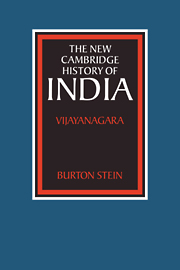Book contents
- Frontmatter
- 1 Introduction
- 2 The medieval past: continuity and disjunction
- 3 The city and the kingdom
- 4 Political economy and society: the sixteenth century
- 5 Imperial collapse and aftermath: 1542–1700
- 6 Conclusion
- Bibliographical essay
- Index
- THE NEW CAMBRIDGE HISTORY OF INDIA
- Frontispiece">
- Plate Section">
5 - Imperial collapse and aftermath: 1542–1700
Published online by Cambridge University Press: 28 March 2008
- Frontmatter
- 1 Introduction
- 2 The medieval past: continuity and disjunction
- 3 The city and the kingdom
- 4 Political economy and society: the sixteenth century
- 5 Imperial collapse and aftermath: 1542–1700
- 6 Conclusion
- Bibliographical essay
- Index
- THE NEW CAMBRIDGE HISTORY OF INDIA
- Frontispiece">
- Plate Section">
Summary
The Vijayanagara kingdom at its greatest moment during the first half of the sixteenth century consisted of few durable elements. Though between 1509 and 1565 Krishnadevaraya, Achyutadevaraya, and Aliya Rama Raja proved competent warriors and statesmen, all were aware of the dangers of assassination by kinsmen and usurpation by other powerful families. By the sixteenth century both threats had been realised too many times for any ruler to be secure. Another hazard were the shifting alliances among the great warlord families of the kingdom. This was especially the condition in the Karnataka and Rayalaseema heartland, the base of royal authority during most reigns. Any king's power depended upon a coalition whose focus he was; a personal relationship with the king opened wide possibilities for any great Deccan magnate. Often a personal relationship could be strengthened by marriage of a daughter into the royal lineage. The powerful Rama Raja, titled aliya, ‘son-in-law’, claimed the throne as husband of the daughter of Krishnadevaraya, and though he was long frustrated in that ambition, some of his considerable authority later derived as much from this affinal connection as from being the son and successor of Aravidi Bukka. Combinations amongst powerful families were shifting and complex; all were alert to advantages and ready to seize political initiatives when the powers of a neighbouring chief or the king weakened.
Keywords
- Type
- Chapter
- Information
- The New Cambridge History of IndiaVijayanagara, pp. 109 - 139Publisher: Cambridge University PressPrint publication year: 1990

